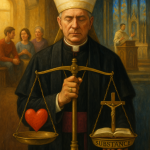I’m playing guitar, all my blogwatches and me…
Hit & Run:
Under a tough new Fairfax County policy, residents can no longer donate food prepared in their homes or a church kitchen — be it a tuna casserole, sandwiches or even a batch of cookies — unless the kitchen is approved by the county, health officials said yesterday.
They said the crackdown on home-cooked meals is aimed at preventing food poisoning among homeless people.
and: “Looks as if one of those tough-love anti-drug boot camps will finally be held responsible for the damage it’s done to a kid, in this case, the ‘damage’ being death….” (much more, with links you should click.)
The Corner:
…Right now, naturalization applicants can pass the test by memorizing 100 specific questions and answers; in the future, assuming this pilot program flourishes the way it should, they will spend more time studying basic ideas about American principles. Two possible questions on the existing test, for example, are:
Who was the main writer of the Declaration of Independence?
When was the Declaration of Independence adopted?
These are indeed facts that all Americans should know, but on a certain level they are trivia. The revised test, however, will ask:
Name one important idea found in the Declaration of Independence.
See the difference? The updated test now promises to become a much-improved tool of immigrant assimilation.
What happens if you answer, “the right of revolution”?
The American Scene: Two really interesting posts from Reihan Salam (this one more relevant to me than this one, though there are analogical resonances with the second post).
The Rat: I am not up to the task of reading the article right now, so I will just quote the same excerpt Ratty does:
…The picture is a modified copy of one [Babbitt] was forced to paint in 1944 as part of Josef Mengele’s murderous theorizing about racial differences. Mengele had plucked Babbitt, a Czech Jew, from a group headed to the gas chambers [at Auschwitz] and ordered the artist to produce portraits of doomed Gypsies that would capture skin tone better than his photographs did.
In 1973, Babbitt was stunned to learn that seven of those nine watercolors had survived and were in the museum at the former concentration camp in Poland. Since then, she has been trying to retrieve them—a quest that raises painful questions about ownership of the products of slave labor as well as the artworks’ role in documenting Holocaust history.











